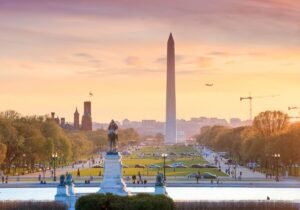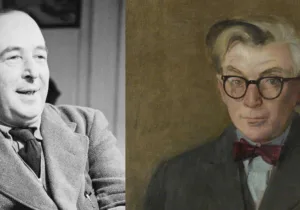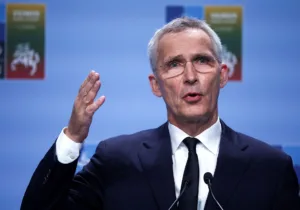I remember the first time I began to understand authoritarianism and its relationship with atrocity. In the spring of 1988, I was studying at Jagiellonian University in Kraków, Poland (which was still Communist), and I had traveled east to Tarnów with my soccer teammate to visit his family. We were watching the government-controlled news at a local pub, and my friend, who had served as a courier for Solidarność during martial law in the early 1980s, remarked how no one believed anything the government said. Conversely, he said, everyone looked to, and believed 100 percent in, America, the home of freedom.
There was no greater fan of America than me, I replied, but we Americans have made our mistakes, from slavery to the Iran-Contra Affair (then in the news). The overall lesson, after repentance, I suggested, was not to lie and to tell the truth. Otherwise, bad things can happen. He agreed and then walked me up to Tarnów’s market square. He told me how the Nazis had rounded up the Jews and killed so many that their blood ran down the streets. I had not yet been to the Nazi death camps at Auschwitz or Majdanek, but my mind’s eye could see blood in the gutters. I understood but remained aghast that such a matter-of-fact massacre could take place after years of Nazi lies about the Jews.
Similarly, my Russian language instructor later shared how the Soviet secret police, also during World War II, had taken her father away in the middle of the night. Along with thousands of other educated leaders of Polish society, the Soviets rounded up the Polish intelligentsia and slaughtered them at Katyń. They were a threat to the forthcoming lies about Joseph Stalin’s occupation of Poland and the promises of Marxism-Leninism.
In 1953, Czesław Miłosz wrote The Captive Mind, detailing how Polish elites ironically succumbed to “Stalinism.” A survivor of the German occupation of Poland, who defected from Communist Poland in 1951, Miłosz observed:
Vulgarized knowledge characteristically gives birth to a feeling that everything is understandable and explained. It is like a system of bridges over chasms. One can travel boldly ahead over these bridges, ignoring the chasms. It is forbidden to look down into them; but that, alas does not alter the fact that they exist.
It is still hard to fathom looking into the chasm of a presidential incitement to insurrection—based on the lie that the election was stolen—which has cost six lives so far. But the deeper chasm is the potential for future lives lost according to the symbolic lies disturbingly visible throughout January 6, 2021, on Capitol Hill: the flag of the Confederacy in the Capitol itself; a lynching noose; T-shirts emblazoned with “Camp Auschwitz” and “6MWE” (“six million wasn’t enough,” a reference to the Jews killed during the Holocaust); and, most vulgarizing for me as a Christian, banners of “Jesus Saves” throughout the crowd, purporting to give Christian legitimacy to the insurrection, and, worse, the latent evil of the symbols in its midst.
We comfort ourselves, saying, “This is not who we are.” But without deeper reflection, such pat answers are lies, strengthening the “vulgarized knowledge” that allow us to ignore the chasms that threaten to consume us. We must look into the chasms—telling the truth to each other, together—if we are to preserve the opportunity to pursue a “more perfect union.”
In 2015, the Equal Justice Initiative provided detailed evidence of over 4,000 “racial terror lynchings” in America between 1877 and 1950. In response, Rod Dreher, a Southern writer for The American Conservative, wrote a blog entitled, “When ISIS Ran the American South.” He concluded:
No, the American South (and other parts of America where racial terrorists ran rampant) was never run by fanatical theocrats who used grotesque public murders as a tool of terror [like ISIS]. But if you were a black in the years 1877-1950, this was a distinction without much meaningful difference.
I made many trips to northern Iraq between 2014 and 2017, working with the Muslim-majority government. As with the Nazis and the Soviets before them, the words and symbols of ISIS dehumanized and demonized those not like them—setting the stage for, and committing, atrocity.
I saw the same in Rwanda, where one Christian tribe murdered another, calling them “cockroaches,” and asking over the radio amidst the genocide, “The grave is half-full, who will help us fill it?” I will never forget walking into the church at Ntarama, just outside Kigali, three years after the 1994 genocide. The site had not been “cleaned up.” The pews were full of blood-spattered clothes, once colorful, bones protruding. They lay where they fell. And if you closed your eyes, you could see the flash of soon-dull machetes. A skull sat on the communion table, looking over the sanctuary.
We approach the same chasm. Make no mistake: evil lurks in those anti-Jewish and anti-Black symbols of January 6—validated by some (QAnon) corruption of Christianity—and it is anxious to take form. The authoritarian script of lies that enable small but steady steps toward atrocity is too tested, and too true.
Now is the time to deepen and expand our individual and institutional capacity to speak truth to each other—as citizens, and within our own faith traditions—so that little lies don’t become the big lie.
Since my time in Poland, I have spent my life combatting authoritarianism worldwide, seeking to come alongside the best in a society and state to prevent their worst. Such an approach requires all, rooted in their respective beliefs, to not just “tolerate” the different races and creeds living side-by-side (diversity), but to engage, respect, and protect them, while also advocating for a legal order that provides equal freedom and fairness for all (covenantal pluralism).
In general, I have found that the best way to deepen this kind of pluralism is to work through the ethnic or religious majority. Working with the majority, especially its faith leaders, gives permission to the rest of their flocks to take part. I make the case that mutual respect among all peoples and beliefs not only creates the most opportunity for stability—which is in everyone’s physical, political, and economic interest—but it is also consistent with the best of who they, the majority, already are, according to their scriptures and traditions. Only the best of faith defeats the worst of religion.
While rapidly changing, the ethno-religious majority in the United States is still white evangelical Christians. It is incumbent upon us, for I am one of them, to say and say again why and how Christ teaches us to see our difference—as He admonished Simon the Pharisee to see the woman washing Christ’s feet (Luke 7:44)—such that we can be whole and holy in Him.
The National Association of Evangelicals denounced the January 6 insurrection, noting the “disturbing conflation of Christianity and a nationalist ideology that is far from the way of Jesus” while “lament[ing] the recurring trauma experienced by people of color in this country.”
Words and worship, along with prayers of repentance and fasting, are a good start. But evangelicals and their fellow Americans will have to do much more than quote Bible verses, write op-eds, or see off a president who is merely a catalytic symptom of these deep chasms.
The long-term key will be a reimagining of education, according to its original purpose: developing good citizens capable of living in a mutually engaged and respectful community under our Constitution.
First, there is a civic duty to renew and require our schools to teach an individual and institutional understanding of e pluribus unum (i.e., how to think). This teaching must also include the cross-cultural religious literacy skills of mutual engagement (i.e., what to do).
Second, the church must recover its capacity to disciple. The events of January 6 are a failure of discipleship. The church cannot tolerate the little lies, the big lie, or the evil symbols in its midst, waiting to take form. Do not underestimate the depth and reach of the QAnon heresy. Only good theology beats bad theology. Evangelical schools, which are part of the church as they integrate faith and learning—from K-12 to colleges and universities—must lead the way in recovering our discipleship, to include a theology of citizenship.
In his 1980 Nobel Prize-winning book, Native Realm: A Search for Self-Definition, Czesław Miłosz reflects that he had “never come across so many good people ready to help their neighbor” as he had in America. This desire and capacity to build bridges of service to each other amidst—and not across—our chasms, is what we need most, now.






 Sponsor a student for Christianity & National Security 2024
Sponsor a student for Christianity & National Security 2024